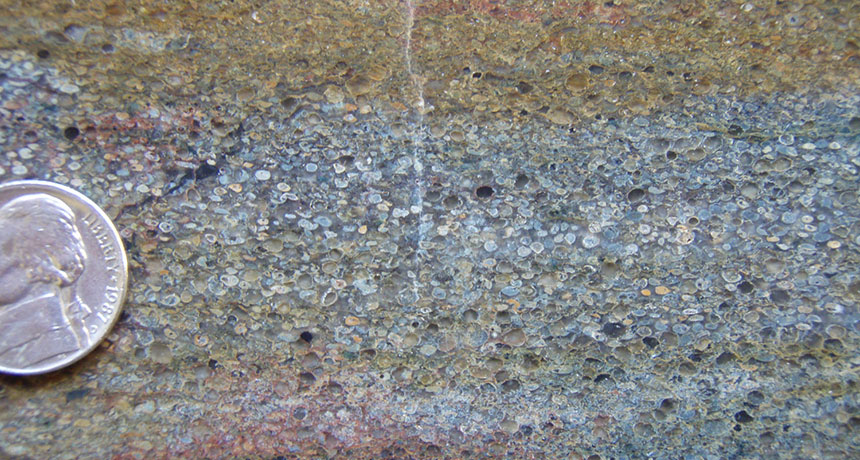
BOILING SEAS Huge asteroid impacts around 3.3 billion years ago boiled Earth’s oceans, new research suggests. Condensing rock vapor from the impacts left spherical bits of rock the size of BB pellets in the rock record, shown.
D. Lowe
- More than 2 years ago
Asteroid impacts around 3.3 billion years ago may have created hell on Earth.
Rocks left over from Earth’s adolescence suggest that giant impacts boiled the oceans billions of years ago, lowering the global sea level by tens of meters. The huge amounts of energy released during the impacts increased air temperatures to more than 500° Celsius for weeks and above water’s boiling point for more than a year, researchers report online May 7 in Geology. These dramatic events would have shaped the evolution of early life on Earth, says geologist Donald Lowe of Stanford University.
“These impacts would have a profound influence on any life trying to evolve into more complex, low-temperature organisms,” says Lowe, the study’s lead author. “They’d keep getting whacked by these giant impactors and driven to extinction or near extinction.”
When Earth was young, space debris left over from the solar system’s creation posed a serious planetary hazard. Massive, planet-sterilizing impacts were common at first (SN: 8/23/14, p. 13), but over time the collisions became smaller and less frequent.
Around 3.3 billion years ago, several large asteroids traveling at roughly 10 kilometers per second slammed into Earth. The massive rocks measured tens of kilometers across, dwarfing the roughly 10-kilometer-wide rock blamed for the dinosaur extinction. The force of these collisions heated the atmosphere, vaporized rock and sent debris flying. Geologists had speculated that these impacts had global effects but lacked geologic evidence of what environmental changes the colossal collisions wrought.
In South Africa, Lowe and geologist Gary Byerly of Louisiana State University in Baton Rouge examined rock layers preserved for about 3.3 billion years. Solidifying rock vapor and debris from two faraway asteroid impacts rained spherical bits of rock about the size of BB pellets, leaving distinctive layers in the rock record.
Lowe and Byerly found sediments below and above each layer that suggest that the location had been deep underwater. The impact layers, however, show erosion indicative of shallower water, suggesting that sea levels dropped by as much as 100 meters following the asteroid impacts before eventually returning to normal. A coating of silica on the impact layer indicates that the sea surface boiled away, leaving behind the dissolved silica. The ocean surface had essentially turned into a global hot spring below a scorching sky, Lowe says. Based on the effects of the impacts, Lowe and Byerly estimate that the asteroids responsible were around 50 to 100 kilometers across.
The findings are exciting but speculative, says geologist James Day of the Scripps Institution of Oceanography in La Jolla, Calif. Since the craters from the impacts aren’t around anymore, it’s hard to precisely nail down how large, and therefore how potentially destructive, the asteroids were, he says.
Understanding the destructive effects of giant impacts is important for understanding the environment in which early life survived and evolved, Lowe says. Many organisms that conducted photosynthesis would probably have lived near the ocean surface and couldn’t have survived temperatures above about 73° C. Only life underground, deeper in the ocean or capable of coping with high temperatures would have survived in a boiling world, Lowe says.
These mass die-offs could have driven early evolution, says planetary scientist Kevin Zahnle of the NASA Ames Research Center in Moffett Field, Calif. A common ancestor to all modern life is thought to have thrived at hot temperatures. That could be because everything that preferred cool conditions got killed in the hot aftermaths of asteroid impacts, Zahnle says. “You can picture these asteroids as a crazed tree trimmer showing up and chopping branches off the tree of life.”






